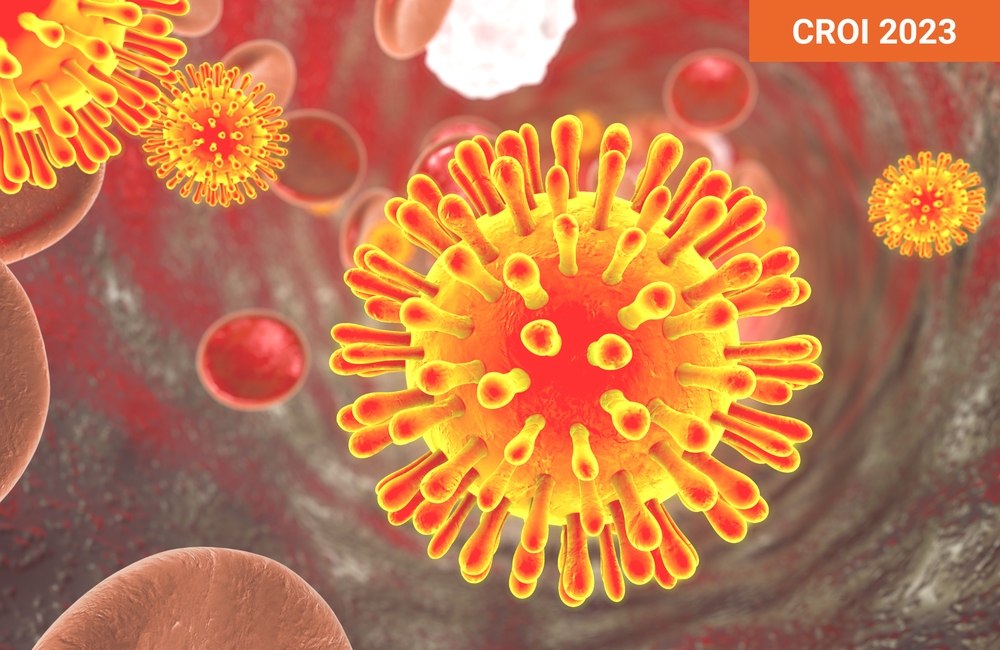
High-level resistance to the integrase inhibitor family of drugs – dolutegravir, cabotegravir, raltegravir, bictegravir and elvitegravir – may arise in a completely different way to what’s been seen in other types of resistance, the 30th Conference on Retroviruses and Opportunistic Infections (CROI 2023) heard last week.
Dr Yuta Hikichi of the US National Cancer Institute and colleagues have found that integrase inhibitors can lose efficacy not due to mutations arising in the drug target, the integrase enzyme, but due to mutations in a completely different part of the virus, its envelope protein. These envelope protein mutations inhibit the normal process of infection of cells via free-floating viral particles (virions), but enhance the ability of HIV to cross between cells via direct cell-to-cell fusion.
This process introduces a larger ‘dose’ of the virus into the infected cells than infection via virions. Integrase inhibitors deal less well with this greater so-called ‘multiplicity of infection’ than other classes.
This finding may explain puzzling instances of integrase inhibitor-based regimens failing despite good adherence and no resistance mutations in the integrase enzyme.
More on the study
One of the reasons integrase strand transfer inhibitors (INSTIs), to give them their full name, have become the drug class of choice as the base of antiretroviral therapy (ART) combinations is because HIV finds it difficult to develop mutations in its integrase enzyme. Even when they arise, the resistance seen is low level and not usually sufficient to produce treatment failure.
This doesn’t explain, however, how a few people still experience treatment failure when taking dolutegravir despite not developing integrase resistance mutations. In one study of dolutegravir as monotherapy, for instance, 7 out of 78 people on monotherapy experienced treatment failure despite documented adequate drug levels, but only two had integrase mutations.
‘Passaging’ – subjecting pathogens to multiple cycles of replication in the lab dish – is an old method of forcing them to adopt mutations. One aim of passaging is to produce weakened strains that can be used in vaccines. Another is forcing them to develop resistance so that ways of overcoming it can be developed.
Dr Hikichi and team subjected HIV to 48 passages, over a year, in the presence of increasing concentrations of dolutegravir, starting with half the IC50 (half the concentration needed to halve the replication rate in non-resistant virus) and ending up with 1000 times that concentration.
They found that while integrase mutations did arise, they were both preceded and outnumbered by mutations in the HIV envelope protein.
One mutation arose at the 19th passage. By the 48th passage, at least four of a characteristic pattern of seven envelope mutations had arisen in every sample. INSTI mutations did arise too, though not till the 30th passage, and one mutation later developed in the nucleocapsid protein.
The seven envelope mutations were scattered all along the chain of amino acids that form the gp160, HIV’s largest protein. Some in particular occurred in places such as the V1/V2 loops which have been the targets of vaccines and broadly neutralising antibodies, used because blocking those positions most strongly affects the virus’s ability to bind to other cells.
The seven envelope mutations moderately weakened the ability of virions to infect cells. In cells infected by unmutated free-floating viruses, the levels of HIV’s reverse transcriptase (RT) enzyme – a measure of viral replication – peaked at week 8 after infection, but at week 12 in viruses with the seven envelope mutations.
However, in the presence of dolutegravir, although the replication of unmutated virus was completely inhibited (as you’d expect), virus with the env mutations was only moderately inhibited, with RT levels peaking at week 14.
It was found that the ‘Env7’ mutations cut HIV’s sensitivity to dolutegravir and cabotegravir by a factor of 2000 and sensitivity to raltegravir by 400. Other drug classes were affected by these mutations too, but not nearly as much: the Env7 mutations cut sensitivity to the reverse transcriptase inhibitors emtricitabine and efavirenz elevenfold and to rilpivirine fourfold, and to the protease inhibitor darunavir sixfold.
"This discovery may provide an explanation for isolated cases of failure of integrase inhibitor-based ART and PrEP regimens."
How could they do this? On the face of it, it makes no sense for a drug’s effect to be cancelled out by a change in a protein that is not the drug’s target molecule and that is active at a completely different time in the HIV lifecycle.
The researchers theorised that the envelope mutations enhanced HIV’s ability to cross from one cell to another by direct transfer, rather than with free-floating virions. This process can happen via multiple mechanisms and may even be the predominant method HIV uses to infect new cells in people with chronic infection who are not taking ART.
This was shown to be the case when the researchers cultivated HIV-infected and uninfected cells together: after 24 hours, three times more cells were newly infected if the infected cells contained HIV with the Env7 mutations than with none.
Cell-to-cell transfer may happen less often than virion transfer but, when it does, it may introduce thirty times as much viral protein into the cell than viral particles. The reason INSTIs cope less well with what’s called the greater multiplicity of infectivity (MoI) in cell-to-cell infection is that they simply can’t ‘get at’ the integrase strand transfer site every time – they are overwhelmed by the higher MoI.
It was found that in cells that had been infected by cell-to-cell transfer and had a high MOI, INSTIs still reduced viral replication 12-fold but non-nucleoside reverse transcriptase inhibitors like rilpivirine were reduced 500-fold.
This appears to be the primary explanation for high-level INSTI resistance without integrase mutation. It was also noted that passaging in the presence of dolutegravir induced mutations in the part of HIV’s gag protein that builds its nucleocapsid, its RNA-containing core. This reduces sensitivity to INSTIs two- to fourfold and may have an accessory role, but is not the primary mechanism.
High-level resistance to integrase inhibitors remains quite uncommon, but this discovery of a completely different pathway to resistance both overturns conventional theories and may also provide an explanation for isolated cases of failure of integrase inhibitor-based ART and PrEP regimens.
Hikichi Y et al. Mutations outside integrase lead to high-level resistance to dolutegravir. Conference on Retroviruses and Opportunistic Infections, Seattle, abstract 103, 2023.

